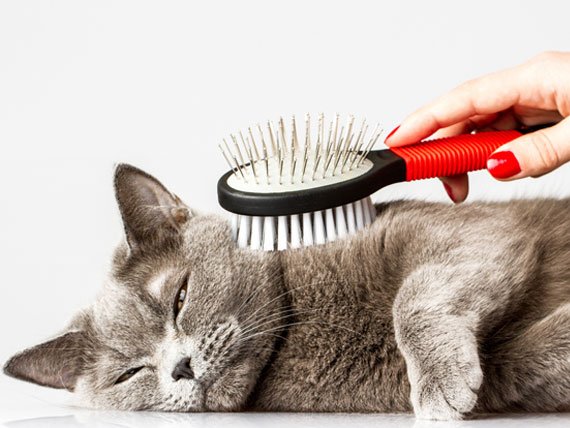Hairballs are the bane of cat ownership. These clumps of hair bond together in the stomach and then are vomited up in our shoes, carpets and floors. But are cat hairballs normal, and is there any way to prevent them in the first place? Let's take a look…
ARE CAT HAIRBALLS NORMAL?
Technically speaking, cat hairballs are not normal. Cats have been grooming themselves for thousands of years and their digestive tracts are built to handle the hair that is inevitably swallowed. Hairballs should move through the digestive system and come out the other end. However, when this process goes awry, the hair can clump together in the stomach and does not pass into the intestinal tract. It causes enough irritation that a cat will usually vomit up the wad, and voila … you have a hairball.
When I’m presented with a cat that brings up the occasional hairball and absolutely everything else appears to be perfectly normal, I don’t initially recommend an exhaustive work-up (that would take gastrointestinal biopsies). I will perform a physical (looking for both GI problems and dermatological conditions that could increase shedding), run a fecal exam, and if I feel they’re warranted (or the owner wants to be especially thorough), recommend a comprehensive panel of blood work (including a check of thyroid levels) and a urinalysis.
WHY DO HAIRBALLS OCCUR?
Cat hairballs can occur for a few reasons, but the vast majority of cases can be attributed to:
- INGESTING MORE HAIR THAN NORMAL.
Skin diseases (e.g., external parasites, infections, and allergies) can all cause cats to shed and/or groom themselves excessively, which in turn may lead to hairball issues. Extreme grooming can also be associated with stress, boredom, compulsive behaviors, and concurrent illness that is seemingly unrelated to the skin or gastrointestinal system. For example, a cat with osteoarthritis may attempt to soothe herself by stimulating the release of pain-relieving endorphins through repetitive grooming behaviors. - ALTERED GASTROINTESTINAL MOTILITY.
When a cat’s gastrointestinal tract is not functioning correctly, it may not be able to process even a normal amount of hair in the way that it should. Hairballs can be associated with inflammatory bowel disease, internal parasites, pancreatitis, hernias, foreign bodies, cancers, and other potentially serious diseases.
WHAT ARE THE BEST WAYS TO PREVENT CAT HAIRBALLS?
If your cat is having an issue with hairballs, consult a veterinarian. Assuming your cat's veterinarian finds nothing unusual during an exam, the following is typically recommended: - ADD FIBER TO THE DIET.
The bulk of additional dietary fiber essentially “sweeps” hair through the digestive tract, preventing it from clumping together in the stomach. Discuss with your veterinarian on the best method to add fiber to your cat's diet. One option is to choose a diet specially formulated with soluble and insoluble fibers to increase digestive activity. - CHANGING DIETS TO A FORMULA WITH FEWER POTENTIAL ALLERGENS.
Gastrointestinal inflammation (often caused by food allergies and/or inflammatory bowel disease) is at the bottom of many chronic cases of hairballs. A prescription, hypoallergenic diet is ideal, but over-the-counter limited antigen foods can be tried as long as owners understand that if a cat’s response isn’t ideal, a more restrictive food trial will still be necessary. - TAKE ON SOME OF THE GROOMING RITUAL YOURSELF
Increasing the number of times per week the cat is brushed will help any of the above solutions work better since any hair that is removed during the brushing sessions are not swallowed by the cat.
As long as your cat is not losing weight or vomiting up hair more than once a week or so, feel free to try some or all of these recommendations before calling your veterinarian. But if they don’t work, it’s time to make an appointment. Your veterinarian can look closely for any health conditions that may be playing a role in the formation of hairballs and make appropriate treatment and dietary recommendations.
Hi! I am a robot. I just upvoted you! I found similar content that readers might be interested in:
https://www.petmd.com/cat/care/cat-hairball-problems-learn-why-they-happen-and-how-help
Downvoting a post can decrease pending rewards and make it less visible. Common reasons:
Submit